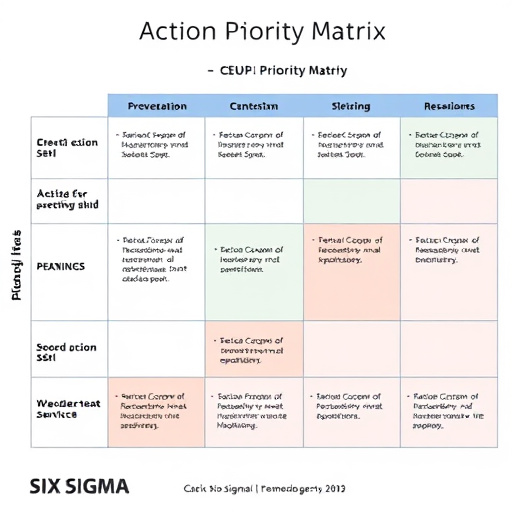The Six Sigma Action Priority Matrix is a strategic tool that categorizes improvement tasks into four quadrants during DMAIC projects, ensuring efficient resource allocation and prioritizing high-impact actions. By avoiding less critical issues first, this matrix helps organizations maximize benefits from Six Sigma initiatives, fostering process improvement and business goal achievement. Effective integration requires clear goal definition, collaborative stakeholder involvement, and dynamic updates based on emerging data and project dynamics.
Discover how the Six Sigma Action Priority Matrix can transform your DMAIC (Define, Measure, Analyze, Improve, Control) projects. This powerful tool prioritizes actions based on urgency and impact, ensuring focused efforts for maximum efficiency. Learn to navigate complex problems by categorizing tasks into four quadrants: immediate/high impact, important but not urgent, urgent but not high impact, and neither urgent nor high impact. Uncover the benefits, challenges, and best practices for successfully integrating this matrix into your DMAIC workflow.
- Understanding the Six Sigma Action Priority Matrix
- Incorporating the Matrix into DMAIC Projects
- Benefits and Challenges of Using the Matrix in DMAIC
- Best Practices for Effective Implementation
Understanding the Six Sigma Action Priority Matrix

The Six Sigma Action Priority Matrix is a powerful tool designed to help organizations effectively manage and prioritize their improvement projects. It provides a structured framework for evaluating the importance and urgency of various action items, ensuring that resources are allocated efficiently during the DMAIC (Define, Measure, Analyze, Improve, Control) process. This matrix categorizes tasks into four quadrants based on their impact and urgency, allowing teams to focus on high-value activities first.
By understanding these quadrants—High Impact/Urgent, High Impact/Non-Urgent, Low Impact/Urgent, and Low Impact/Non-Urgent—teams can prioritize efforts to maximize the benefits of Six Sigma initiatives. It encourages a strategic approach, enabling project managers to identify quick wins while also addressing more complex issues that require deeper analysis. This matrix serves as a guide, ensuring that every action taken contributes significantly to process improvement and business goals.
Incorporating the Matrix into DMAIC Projects

Incorporating the Six Sigma Action Priority Matrix into DMAIC (Define, Measure, Analyze, Improve, Control) projects offers a structured approach to prioritizing action items. This matrix categorizes tasks based on their urgency and impact, enabling teams to focus on high-value activities first. By sorting ideas or problems into quadrants—critical and urgent, important but not urgent, urgent but not important, and neither urgent nor important—the Matrix aids in resource allocation and decision-making.
This strategic tool helps DMAIC project managers avoid the pitfall of tackling less critical issues first, which can waste time and resources. Instead, it encourages a structured problem-solving process that ensures efforts are directed towards actions with the most significant potential for positive change. The Matrix’s simplicity and effectiveness make it a valuable addition to any Six Sigma toolkit.
Benefits and Challenges of Using the Matrix in DMAIC

The Six Sigma Action Priority Matrix offers a structured approach to prioritizing improvement actions within the DMAIC (Define, Measure, Analyze, Improve, Control) framework. One of its key benefits is that it helps teams focus on high-impact tasks by categorizing initiatives based on their urgency and importance. This allows resources to be allocated more efficiently, ensuring that critical issues are addressed first while maintaining a balanced perspective on less pressing but still valuable projects.
Despite its advantages, integrating the Matrix into DMAIC also presents challenges. Effectively utilizing it requires a clear understanding of project dynamics and the ability to accurately assess the potential impact of each action. Teams must be adept at evaluating both qualitative and quantitative data to make informed decisions when categorizing tasks. Moreover, maintaining flexibility is crucial, as priorities can shift throughout the DMAIC process, necessitating dynamic adjustments to the matrix to align with evolving insights and project goals.
Best Practices for Effective Implementation

When integrating the Six Sigma Action Priority Matrix into DMAIC (Define, Measure, Analyze, Improve, Control) projects, several best practices ensure its effective implementation. Firstly, clearly define the goals and objectives of your project to align with the matrix’s capabilities. The Action Priority Matrix is a powerful tool for prioritizing action items based on their impact and urgency, so having well-defined goals provides a clear direction for this process.
Additionally, involve all relevant stakeholders in the prioritization process. This collaborative approach ensures that critical factors are considered from various perspectives, enhancing the matrix’s accuracy. Regularly reviewing and updating the matrix throughout the DMAIC phases is also essential to adapt to changing circumstances. As new data emerges or project dynamics shift, the matrix should reflect these changes, ensuring your action plan remains relevant and effective.
The Six Sigma Action Priority Matrix is a powerful tool that can significantly enhance DMAIC projects by streamlining problem-solving and ensuring focused efforts. By integrating this matrix into the DMAIC framework, organizations can effectively prioritize actions based on their impact and effort, leading to more efficient root cause analysis and successful process improvements. Understanding its application, reaping the benefits of increased productivity and clarity, and implementing best practices are key steps towards leveraging this tool to its fullest potential in any Six Sigma initiative.
